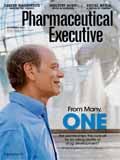
- Sustainability
- DE&I
- Pandemic
- Finance
- Legal
- Technology
- Regulatory
- Global
- Pricing
- Strategy
- R&D/Clinical Trials
- Opinion
- Executive Roundtable
- Sales & Marketing
- Executive Profiles
- Leadership
- Market Access
- Patient Engagement
- Supply Chain
- Industry Trends
Pharma and Social Media: Ready to Make Nice?
The time is right for industry to overcome its social media phobia once and for all.
Reading about pharma's bumpy relationship with social media is a little like following celebrity marriage plans in the tabloids. One minute it's on, the next it's off. On again, off again.
Throwing pharma and social media together brings an unprecedented opportunity to reach an audience that is growing exponentially alongside unparalleled opportunities for stakeholder engagement. Pushing them apart are old familiar worries about adverse event and off-label discussions compounded by the delay of FDA guidelines.
The constant to-and-fro seems to be creating a real sense of social media fatigue in parts of the industry, but could pharma really call it a day and bow out of the biggest social communications revolution in history?
"Going dark" is not really much of an option, argues Thomas L. Harrison, CEO of Omnicom Group, in an August Pharm Exec blog post about the challenges pharma faces in working with Facebook's new mandate. Beginning Aug. 15, Facebook mandated that only pages dedicated solely to a prescription drug have the option to disable commenting. Harrison believes that companies that abandon Facebook will miss out on a "powerful community that is already woven into billions of lives whose voices want and need to be heard." This has to hold true for other social media platforms, from Twitter to bespoke disease or therapeutic communities.
So how can pharma make its relationship with social media work?
The answer is "carefully," according to independent consultant Alexandra Fulford on her pharmaGuapa.com blog. London-based Fulford outlines an approach based on the "Stop, Look & Listen" technique used to teach schoolchildren how to cross the road without getting run over.
Stop: Pharma needs to cease being afraid of social media; instead, see it as just another communication channel, and wait to see what will happen. Progress can be made within the current regulatory system.
Look: Don't run into the middle of the road; look first to see what other pharma companies have done and are currently doing in the social space. Learn from their mistakes and their successes.
Listen: All successful social media initiatives have one key action in common: listening. In a two-way medium it is vital to listen to what your target audience is discussing and to keep listening.

Benefit from industry updates and case studies related to this article
3rd Annual Life Sciences Forum on Social Media Regulations and Compliance
Leverage Digital Networks while Ensuring Promotional Compliance
June 19-20, 2012
Alexandria, Virginia
Setting a Bad Example
Pharma's problem with listening is that it means letting people talk first, and this is where much of pharma's fear of social media lies. The calls for pharma to quit using social media tend to rest heavily on a few well-rehearsed horror stories involving damaging public comments. One of the best known is the case of the VOICES Facebook page set up by Sanofi Aventis to "empower" employees, friends, families, and communities but hijacked by disgruntled users of its drug Taxotere.
Alongside an unflattering picture of a balding head, one visitor to the VOICES wall wrote: "This is my disfigurement from your drug Taxotere, the drug [where] you kept this adverse side effect secret. Why don't you want to answer my letters and e-mails?"
Sanofi removed the antagonistic comments, but others quickly appeared in their place, reiterating the earlier comments and asking why the post had been removed. Social media experts smelled a rat, believing the posts could be the work of a competitor, or an organized campaign by a PR company employed by a lawyer representing a disgruntled patient. It turned out that the attack was, largely, the work of one person: a female cancer patient, who had a lot to say on the subject of chemotherapy-induced alopecia.
It's tough to see what Sanofi could have done to avoid such a determined assault, but a clear—and clearly visible—Terms of Use policy would have made it easier to deal with. Sanofi's corporate communications department was later obliged to make the Terms of Use more conspicuous on the VOICES page, commenting: "Because social media is evolving at a rapid rate, the company continues to refine our extensive guidelines regarding how to address dialogue about our company on social media sites such as Facebook and Twitter."
There was also the case of Procter & Gamble's Asacol Community site for ulcerative colitis (UC) patients. The Community offered a forum for patients to share their stories of the condition, and guidelines were put in place that deemed that Asacol or other drug treatment options could not be mentioned by name. The content was moderated, but consumers could, it was claimed, rate and vote on story content and answers.
The 'moderated chat,' however, was somewhat too moderated. Comments could not be submitted in response to a story, 'votes' did not appear to be counted, and it could take up to "three business days" to see a user comment posted. After asserting that "most consumers never read guidelines or Terms and Conditions as carefully as I do," PharmaGuy noted in a 2009 blog post, he concluded that the "Asacol Community is NOT a real community and NOT a real chat."
In addition to Facebook, pharma has also run into trouble with YouTube and Twitter. FDA served Warner Chilcott with a warning letter in May for a video posted to YouTube starring one of their sales reps. The video was posted by the rep "under the direction of a Warner Chilcott district manager," according to the letter. The video misbranded the drug Atelvia and made unsubstantiated claims about the drug and dosage, omitted risk information, and so on. In the UK, on Twitter, Bayer ran afoul of the Prescription Medicines Code of Practice Authority's Code of Conduct, after several tweets promoting Levitra and Sativex went out to consumers, which is of course illegal in the UK. The tweets were accused of not presenting risk information appropriately.
Taking Control
The first of the Big Pharmas to take the plunge and establish–in the absence of direction from the regulators–some internal guidelines for using social media was Roche. In August 2010 the Swiss drugmaker went public with a transparent standard for online behavior (see Pharm Exec, October 2010).
Roche came up with 14 Social Media Principles that made explicit the need to: 1) differentiate between using social media in a personal versus professional contexts; 2) build clarity in speaking about the company and on behalf of it, through third parties; and 3) advocate for employees to serve as "scouts" in tapping networks to identify "sentiment and critical issues."
The move was broadly welcomed by digital pharma commentators, with Andrew Spong calling it "trust-enabling," a "spur to ethical conduct," and heralding "a new era for healthcare communications." But it was not without some controversy. By trying to bring structure to the kind of ambivalent behavior that obscures the dividing line between personal and professional use of social media, the company was also inviting criticism for fusing the personal and professional and, at worst, creating an environment that smacked of Big Brother in its monitoring of staff social media use.
Sabine Kostevc, Roche's head of corporate Internet and social media, responded to Pharm Exec saying, "It is a fact of life that people will always discuss topics or issues around us—online and offline—and nobody is in a position to prevent this. We can only try to make sure that it happens in a responsible way where our employees are involved. We merely wanted to offer guidance on where to go if colleagues come across any issues. Apart from that, all employees are educated and required to report adverse event information that they encounter, [regardless of the] communication channel."

Benefit from industry updates and case studies related to this article
3rd Annual Life Sciences Forum on Social Media Regulations and Compliance
Leverage Digital Networks while Ensuring Promotional Compliance
June 19-20, 2012
Alexandria, Virginia
Finding the Right Balance
Guidelines are great, control is sometimes necessary, but stifling dialogue not only defeats the purpose of the social media exercise, it bolsters the perception that pharma is, at best, not listening and, at worst, manipulative. The secret is striking a balance, and there are real communities out there that pull it off.

What’s Your Digital IQ?
Johnson & Johnson's Children With Diabetes is a strong example of a pharma-owned online community where patients more or less can freely discuss products with each other and with J&J company officials. This might be because Children With Diabetes was founded and created by parents of diabetic children, and then acquired by J&J, so the company approaches it with an extremely light touch.
PKU.com is a social community for phenylketonuria (PKU) patients built by Biomarin Pharmaceuticals and is clearly associated with the company, linking to Kuvan.com, the site for the Kuvan PKU drug sold by Biomarin. Still, the site hosts lively discussions among its members. This is on a relatively small scale—Kuvan is an orphan drug—but it's a good example of a community built by pharma from the ground up that is actually working.
But therapeutic or disease communities are relatively sedate affairs. What about the real-time rough and tumble of Twitter and Facebook?

PharmaWall: Allowing Pharma to Face Up to Facebook?
AstraZeneca recently ventured into Twitter discussions in February, hosting a one-hour chat on the #RXsave hashtag to raise awareness about its prescription savings programs. Response to the chat session was generally positive, and in a recent tweet AZ announced that enrollment in its prescription savings programs was up 10 percent.
Pharma's relationship with Facebook is difficult right now, but Boehringer Ingelheim's corporate Facebook page, with wall comments fully enabled, is widely considered to be an example of pharma getting Facebook right.
How can other pharma companies get it right? Follow the advice Thomas L. Harrison gave pharma ahead of Facebook's Aug. 15 rule change: put the staff in place and build an infrastructure to monitor Facebook and other social networking sites; get the data collection systems in place to capture relevant information; and put protocols and legal oversight in place to review that information and report it to the appropriate regulatory bodies.

Across Health’s 2011 digital landscape survey of life sciences leaders in Europe found limited investment in digital marketing; barriers to implementation, from regulatory issues to lack of strategy; and a heavy reliance on older website marketing techniques, combining to leave industry execs very dissatisfied with digital activities.

Benefit from industry updates and case studies related to this article
3rd Annual Life Sciences Forum on Social Media Regulations and Compliance
Leverage Digital Networks while Ensuring Promotional Compliance
June 19-20, 2012
Alexandria, Virginia
This might seem like a lot of effort just to let an undefined group who may or may not be patients have their say, but Harrison describes the rewards for opening up on Facebook in very mechanical terms. "Companies currently blocking commentary on Facebook are not reaching nearly as many readers as they could—or as meaningfully."
Harrison explains that when most people logon to Facebook, the first thing they see is their news feed. This is governed by an algorithm that chooses what news you will see from the friends and other pages you most frequently interact with. This is known as your 'EdgeRank,' and a page that doesn't allow comments will basically achieve a zero EdgeRank.
"That can mean that few will ever see your posts, which largely defeats the purpose of having a Facebook page in the first place."
Harrison believes the change in Facebook's policy will actually prove to be an opportunity for the pharmaceutical industry "to engage in a heightened dialogue with consumers, customers, shareholders, and other interested parties."
And this is the promise of social media: the chance to connect with stakeholders and discuss how to make more of the good things pharma does and how to fix the things that aren't so good.
There clearly is no silver social media bullet for pharma. The concerns of the industry are different from your local bakeshop using Twitter to push two-for-one cupcakes. But that's no different from any other communications scenario we could imagine before social media.
Pharma needs to approach social media in a way that works best for it; whatever platforms get used are secondary. Pharma blogger Steve Woodruff wants the industry to spend less time worrying about "getting on" Facebook or Twitter, and more time "architecting a social strategy that fits the industry–rather than trying to fit this square industry peg into a round, shape-shifting hole."
This might mean creating "walled gardens" where discussion is controlled among carefully managed groups; it might mean only using mainstream platforms for corporate or non-therapeutic communications; it might mean something that hasn't been invented yet. But what pharma should not do is walk away from social media, as this is likely to be, ultimately, the most damaging course of action.

Benefit from industry updates and case studies related to this article
3rd Annual Life Sciences Forum on Social Media Regulations and Compliance
Leverage Digital Networks while Ensuring Promotional Compliance
June 19-20, 2012
Alexandria, Virginia

2 Commerce Drive
Cranbury, NJ 08512
All rights reserved.